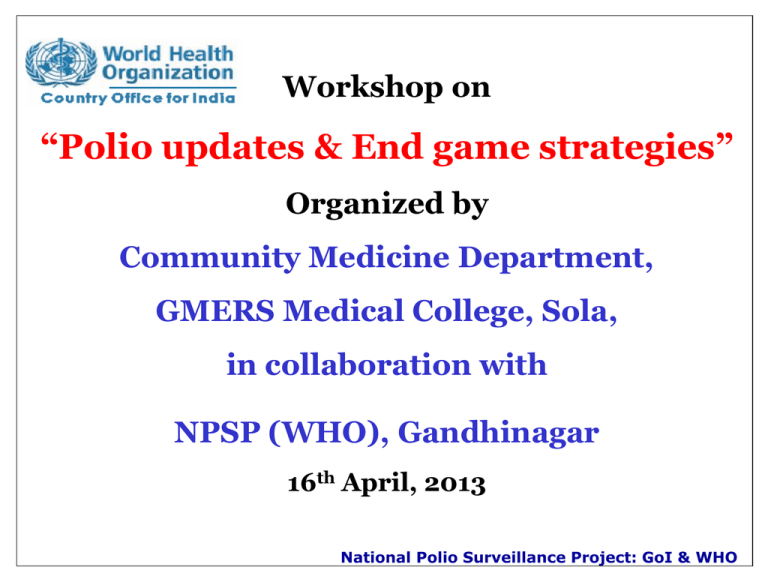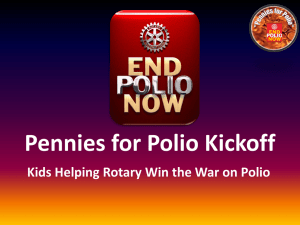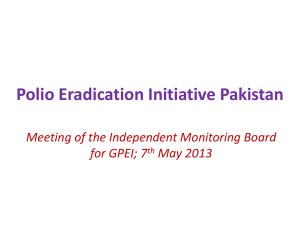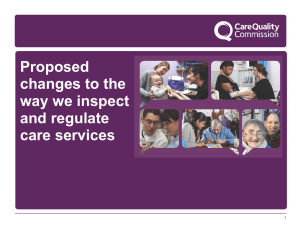
Workshop on
“Polio updates & End game strategies”
Organized by
Community Medicine Department,
GMERS Medical College, Sola,
in collaboration with
NPSP (WHO), Gandhinagar
16th April, 2013
National Polio Surveillance Project: GoI & WHO
Polio update, AFP Surveillance
End game strategy
Dr. Anish Sinha
State Surveillance Medical Officer
World Health Organization
National Polio Surveillance Project, India,
Gandhinagar.
National Polio Surveillance Project: GoI & WHO
Contents….
•
•
•
•
•
•
Global/ National / State update.
Epidemiology of polio.
AFP Surveillance.
SIAs (NIDs / SNIDs).
Certification of Polio eradication.
End game strategy.
National Polio Surveillance Project: GoI & WHO
Areas with Active Polio Transmission
1988
350 000 cases
2012
223 cases
125 countries
5 countries
National Polio Surveillance Project: GoI & WHO
Rukhsar Khatoon last case of WPV detected in
India (Jan 2011), her mother Shabida Bibi in
Shahapar village, WB
National Polio Surveillance Project: GoI & WHO
India
• India last polio case on 13th Jan.2011
• Removed from list of ENDEMIC
Countries list in Feb.2012
Looking forward for Certification
(SEAR) in Feb.2014
National Polio Surveillance Project: GoI & WHO
Global Polio updates 2012
Nigeria
(122)
Pakistan
(58)
ONLY THREE ENDEMIC COUNTRIES
Afghanistan
(37)
CHAD 5 WPV1 (IMPORTATION)
Niger 1WPV1
Till 9 Apr 13 – 18 cases (Nig-11, Pak-6, Afg-1)
National Polio Surveillance Project: GoI & WHO
WPV transmission from Northern Sindh, Pakistan to
Greater Cairo (environmental sample +ve), Egypt
Importation of WPV 2013 -, Egypt - polio free since 2004.
National Polio Surveillance Project: GoI & WHO
WPV cases, India
2100
1934
No case since Jan 2011
1800
1600
1500
1126
1200
874
900
741
676
559
600
265
300
268
225
134
66
42
0
1998
1999
2000
2001
2002
2003
P1 wild
* data as on 12 April 2013
2004
2005
2006
P2 wild
2007
2008
2009
2010
1
2011
0
0
2012 2013*
P3 wild
National Polio Surveillance Project: GoI & WHO
Location of wild poliovirus and VDPV cases by type, India
2011
WPVs
State
P1
P3
Total
West Bengal
1
0
1
Total
1
0
1
VDPVs
State
P2
P3
Total
Chhattisgarh
1
0
1
Madhya Pradesh
1
0
1
Orissa
0
1
1
Punjab
1
0
1
Rajasthan
1
0
1
Uttar Pradesh
2
0
2
Total
6
1
7
* data as on 12 April 2013
2013*
2012
VDPV
State
West Bengal
Total
VDPV
P2
1
1
State
Bihar
Total
P2
1
1
National Polio Surveillance Project: GoI & WHO
Last wild poliovirus cases by type, India
WPV2
24/10/1999
Aligarh (UP)
WPV3
22/10/2010
Pakur (JH)
WPV1
13/01/2011
Howrah (WB)
* data as on 12 April 2013
National Polio Surveillance Project: GoI & WHO
Wild poliovirus detected in sewage samples, 2010 – 2011
2010
Mumbai
Mumbai
Week
1
2
3
4
5
6
7
8
9
10 11 12 13 14 15 16 17 18 19 20 21 22 23 24 25 26 27 28 29 30 31 32 33 34 35 36 37 38 39 40 41 42 43 44 45 46 47 48 49 50 51 52
X
F ward
X
X
X
X
G ward
M ward
Delhi
Delhi
Week
1
2
3
4
5
6
7
8
9
10 11 12 13 14 15 16 17 18 19 20 21 22 23 24 25 26 27 28 29 30 31 32 33 34 35 36 37 38 39 40 41 42 43 44 45 46 47 48 49 50 51 52
X
Red cross hospital
X
X
Bhalaswa lake
X
X
Wazirpur JJ colony
X
X
Swarn cinema
X
Batala house (Okhla)
X
X
X
X
X
X
X
X
Mumbai
2011
Week
1
2
3
4
5
6
7
8
9
10 11 12 13 14 15 16 17 18 19 20 21 22 23 24 25 26 27 28 29 30 31 32 33 34 35 36 37 38 39 40 41 42 43 44 45 46 47 48 49 50 51 52
Week
1
2
3
4
5
6
7
8
9
10 11 12 13 14 15 16 17 18 19 20 21 22 23 24 25 26 27 28 29 30 31 32 33 34 35 36 37 38 39 40 41 42 43 44 45 46 47 48 49 50 51 52
F ward
G ward
M ward
Delhi
Red cross hospital
X
Bhalaswa lake
X
X
Wazirpur JJ colony
X
X
Swarn cinema
X
X
X
X
Batala house (Okhla)
X
X
X
X
X
X
X
X
X
X
X
X
X
X
X
X
X
X
X
X
X
Nangloi
X
X
X
Sonia vihar
X
X
X
X
X
X
X
Patna
Week
1
2
3
4
5
6
7
8
9
10 11 12 13 14 15 16 17 18 19 20 21 22 23 24 25 26 27 28 29 30 31 32 33 34 35 36 37 38 39 40 41 42 43 44 45 46 47 48 49 50 51 52
1
2
3
4
5
6
7
8
9
10 11 12 13 14 15 16 17 18 19 20 21 22 23 24 25 26 27 28 29 30 31 32 33 34 35 36 37 38 39 40 41 42 43 44 45 46 47 48 49 50 51 52
Choti pahari
Dujara
Transport nagar
Kolkata
Week
Ward 8, MM
Ward 135, KMC
Wild poliovirus type 1
Wild poliovirus type 3
Negative for wild poliovirus
X
Sampling not scheduled
Scheduled butPolio
sample Surveillance
not collected
National
Project: GoI & WHO
Wild poliovirus detected in sewage samples, 2012*
Mumbai
Week
1
2
3
4
5
6
7
8
9
10 11 12 13 14 15 16 17 18 19 20 21 22 23 24 25 26 27 28 29 30 31 32 33 34 35 36 37 38 39 40 41 42 43 44 45 46 47 48 49 50 51 52
X
F ward
X
X
X
G ward
M ward
Delhi
Week
1
2
3
4
5
6
7
8
9
10 11 12 13 14 15 16 17 18 19 20 21 22 23 24 25 26 27 28 29 30 31 32 33 34 35 36 37 38 39 40 41 42 43 44 45 46 47 48 49 50 51 52
1
2
3
4
5
6
7
8
9
10 11 12 13 14 15 16 17 18 19 20 21 22 23 24 25 26 27 28 29 30 31 32 33 34 35 36 37 38 39 40 41 42 43 44 45 46 47 48 49 50 51 52
Red cross hospital
Bhalaswa lake
Wazirpur JJ colony
Swarn cinema
Batala house (Okhla)
Sonia vihar
Nangloi
Patna
Week
X
Choti pahari
X
X
Dujara
X
Transport nagar
X
X
X
X
X
X
X
X
X
X
X
X
X
X
X
X
X
X
X
X
X
X
X
X
X
X
X
X
X
Kolkata
Week
1
2
3
4
5
6
7
8
9
10 11 12 13 14 15 16 17 18 19 20 21 22 23 24 25 26 27 28 29 30 31 32 33 34 35 36 37 38 39 40 41 42 43 44 45 46 47 48 49 50 51 52
Ward 8, MM
Ward 135, KMC
Ward 29, KMC
Ward 66, KMC
* data as on 12 April 2013
`
Wild poliovirus type 1
Negative for wild poliovirus
Wild poliovirus type 3
Result pending
X
Scheduled but sample not collected
Sampling not scheduled
National Polio Surveillance Project: GoI & WHO
Wild poliovirus detected in sewage samples, 2013*
Mumbai
Week
1
2
3
4
5
6
7
8
9
10 11 12 13 14 15 16 17 18 19 20 21 22 23 24 25 26 27 28 29 30 31 32 33 34 35 36 37 38 39 40 41 42 43 44 45 46 47 48 49 50 51 52
Week
1
2
3
4
5
6
7
8
9
10 11 12 13 14 15 16 17 18 19 20 21 22 23 24 25 26 27 28 29 30 31 32 33 34 35 36 37 38 39 40 41 42 43 44 45 46 47 48 49 50 51 52
2
3
4
5
6
7
8
9
10 11 12 13 14 15 16 17 18 19 20 21 22 23 24 25 26 27 28 29 30 31 32 33 34 35 36 37 38 39 40 41 42 43 44 45 46 47 48 49 50 51 52
F ward
G ward
M ward
Delhi
Red cross hospital
Bhalaswa lake
Wazirpur JJ colony
Swarn cinema
Batala house (Okhla)
Sonia vihar
Nangloi
Patna
Week
1
X
Choti pahari
X
X
Dujara
Transport nagar
X
X
X
X
X
X
X
X
X
X
X
X
X
X
X
X
X
X
X
X
X
Kolkata
Week
1
2
3
4
5
6
7
8
9
10 11 12 13 14 15 16 17 18 19 20 21 22 23 24 25 26 27 28 29 30 31 32 33 34 35 36 37 38 39 40 41 42 43 44 45 46 47 48 49 50 51 52
Ward 8, MM
Ward 135, KMC
Ward 29, KMC
Ward 66, KMC
* data as on 12 April 2013
Wild poliovirus type 1
Negative for wild poliovirus
Wild poliovirus type 3
Result pending
X
Scheduled but sample not collected
Sampling not scheduled
National Polio Surveillance Project: GoI & WHO
Progress in India–A snapshot
2100
1934
1800
1600
1500
•
1995: Polio SIAs (campaigns) launched
•
1997: Acute Flaccid Paralysis (AFP) Surveillance initiated
•
1999: Last case of Wild Polio Virus (WPV) type 2 – (U.P)
•
2010: Last case of WPV type 3 - (Jharkhand)
•
2011: Last case of WPV type 1 - ( West Bengal)
•
2012: India removed from list of endemic countries
1126
1200
874
900
741
676
559
600
265
300
268
225
134
66
42
0
1998
1999
2000
2001
2002
2003
P1 wild
* data as on 12 April 2013
2004
2005
2006
P2 wild
2007
2008
2009
2010
1
2011
0
0
2012 2013*
P3 wild
National Polio Surveillance Project: GoI & WHO
Gujarat Wild Cases 2000-13
Year - Cases
BAN
2000 - 2
2001 - 1
PAT
KTC
2002 - 24
2003 - 3
RJT
SRN
AND
JMD
2005 - 1
2007 - 1
2008 - 0
2009 - 0
2010 - 0
2011 - 0
2012 - 0
2013 - 0
JMC
PML
GNR
AMC
KDA
AMD
2004 - 0
2006 - 4
SBK
MSN
BVC
DHD
VDC
VDD
RJC
POR
AML
JUN
BVN
BRH
NMD
SRC SRT
NAV
DNG
VLD
National Polio Surveillance Project: GoI & WHO
Epidemiology of Polio
National Polio Surveillance Project: GoI & WHO
Polio: Epidemiology
• Reservoir of infection: Man (for every clinical case,1000
sub clinical case (children) & 75 (adults)
• Infective material: feces
• Period of communicability: most infective 10 days
before & after onset.
Host factors
• Age:6 months to 3 years most common
• Sex: 3:1 ---male: female
• Precipitating factors: fatigue, trauma, I/M injections
• Immunity : OPV (life long)
Environmental factors
• Rainy season (Jun – Sep), overcrowding & poor
sanitation
National Polio Surveillance Project: GoI & WHO
Paralytic Poliomyelitis
• Acute onset
• Fever just prior to onset of paralysis
• Associated symptoms: malaise, sore throat, constipation
abdominal pain. Muscle pain
• Signs of meningeal irritation, stiffness in back & neck may be
present.
• Progression: maximum in <4 days. starts proximally and
moves distally
• Involvement: asymmetrical patchy paralysis ,proximal muscle
groups> distal muscle groups
• DTR: diminished
• Cranial nerve involvement : uncommon
• Respiratory insufficiency: life threatening, uncommon
• Sensory: no loss
only way to confirm is isolation of wild virus from stool.
National Polio Surveillance Project: GoI & WHO
Strategies of Polio Eradication
1985 – Routine immunization
Individual immunity
1995 – NID’s ( PPI / IPPI )
To replace wild with vaccine virus
1997 - AFP surveillance
To identify reservoir of transmission
2000 – Mopping up immunization
To eliminate last foci of transmission
National Polio Surveillance Project: GoI & WHO
AFP Surveillance
National Polio Surveillance Project: GoI & WHO
Objective of AFP surveillance
Reliably detect areas where polio
transmission is occurring or likely to occur
National Polio Surveillance Project: GoI & WHO
Principle of AFP Surveillance in identifying
polio cases
Identify children with the SYNDROME of Acute Flaccid
Paralysis
• Acute- Sudden onset, Rapid progression
• Flaccid- Floppy/ soft & yielding to passive stretching at
anytime during the illness.
• Paralysis is loss of strength of muscles,
Severe loss of motor strength is called paralysis or plegia
Paresis- less severe loss of motor strength
National Polio Surveillance Project: GoI & WHO
Definition of AFP for surveillance purposes
Sudden onset weakness & floppiness in
any part of the body in a child < 15
years of age or paralysis in a person of
any age in which polio is suspected.
National Polio Surveillance Project: GoI & WHO
Logic of AFP investigation & stool sample
collection
• Sensitivity increases when all AFP cases
investigated
• Testing of stools of all AFP - most valid test for
identification of Polio
• ALL cases with ‘AFP’ should be reported &
their stools must be tested!!
• Even if other ‘tests’ (CT scan, MRI, etc.) or
additional clinical information point to other
diagnoses; stools must be tested to rule out Polio
National Polio Surveillance Project: GoI & WHO
Reporting
• All AFP cases should be reported immediately
• ALL AFP cases reported within 6 months of
onset of paralysis should be investigated
• All reporting units, informers and other contacts
should continue to report AFP cases as per
existing case definition
National Polio Surveillance Project: GoI & WHO
Action when AFP is reported
• FIRST – Start stool collection process
• Investigate - SMO/ DIO - Confirm if AFP, if not reject
case & record the same.
There is only one category of cases - AFP
• Allot EPID number & Report the case as AFP
• CIF & LRF should be filled.
• Use the revised CIF/ Linelist form.
• Ensure that stools are transported to lab in cold chain
• NPSU will Classify after lab result received
• Give feedback to the source that the AFP reported was/
was not polio.
• Maintain documentation at ALL levels.
National Polio Surveillance Project: GoI & WHO
Therefore…
The basic system of AFP surveillance remains
unchanged
• To enhance sensitivity, all cases of acute flaccid
paralysis should be reported & investigated
• Borderline cases should be included & stool
specimens tested
National Polio Surveillance Project: GoI & WHO
The AFP Surveillance System
Hospitals
Clinics
Community
Investigation
Non-Polio AFP
Polio AFP
National Polio Surveillance Project: GoI & WHO
When too much polio is around…..
AFP cases
Polio cases
Borderline AFP cases
Non-AFP cases
Surveillance
sensitivity is
adequate enough
to detect 90%
polio cases
National Polio Surveillance Project: GoI & WHO
When transmission is very low…..
If borderline
cases are
taken &
stool
specimens
collected …
Surveillance
sensitivity is
not good
enough &
detects only
50% polio
cases
…Sensitivity
increases
and leads to
100%
detection of
polio cases
AFP cases
Polio cases
Borderline cases
Non-AFP cases
Remember Non AFP cases still not taken
National Polio Surveillance Project: GoI & WHO
Likely to be AFP cases….
•
•
•
•
•
•
•
GBS of any variety
Transverse myelitis
Monoparesis
Traumatic neuritis
Flaccid Paraplegias
Flaccid Quadriplegia
Isolated bulbar
paralysis
• Post-diphtheric
polyneuritis
• Viral neuritis,
• Flaccid hemiplegia
• Isolated neck
paralysis
• Wrist/foot drop, etc.
• Transient paresis
• Facial Palsy.
National Polio Surveillance Project: GoI & WHO
Analysis of initial clinical presentation of WPV 2006 - 10
Clinical Presentation
2006
2007
2008
2009
2010
586 (86.7)
757 (86.71)
494 (88.37)
648 (87.45)
32 (76.19)
Only H/O Paralysis
24 (2.7)
14 (1.60)
14 (2.5)
10 (1.35)
1 (2.38)
Hemiplegia
35 (5.2)
54 (6.19)
25 (4.47)
48 (6.48)
3 (7.14)
G.B.Syndrome
6 (0.9)
3 (0.34)
3 (0.54)
3 (0.40)
Traumatic Neuritis
4 (0.6)
8 (0.92)
1 (0.18)
2 (0.27)
Only Limp
4 (0.6)
1 (0.11)
0 (0)
4 (0.54)
Acute Encephalitis
3 (0.4)
3 (0.34)
4 (0.72)
1 (0.13)
Isolated Facial Palsy
3 (0.4)
19 (2.18)
10 (1.79)
14 (1.89)
Isolated Neck Flop
4 (0.6)
5 (0.57)
4 (0.72)
4 (0.54)
0 (0)
2 (0.23)
0 (0)
1 (0.13)
7 (1.0)
7 (0.80)
4 (0.72)
6 (0.81)
2 (4.76)
676
873
559
741
42
Clinical Poliomyelitis
Post Diptheric
Polyneuritis
Others
Total
4 (9.52)
National Polio Surveillance Project: GoI & WHO
STOOL COLLECTION, STORAGE ,
TRANSPORT.
• Adequate Stool.
– 2 Specimens, 24 Hours Apart.
– 8 gms.
– Within 14 Days of Paralysis Onset & with proper Cold Chain
• Procedure.
– Errors.
– Storage(Delayed Second Sample)
• Cold Chain.
• Rectal Tube.
• Transport.(PHN & HA)
• Death of AFP Case.( Spinal Cord , Intestinal Content)
National Polio Surveillance Project: GoI & WHO
GOLD STANDARD FOR AFP
SURVEILLANCE
• Non – Polio AFP Rate > 2.0
• Adequate Stool Samples > 80%
• Timeliness of Reporting > 80%
National Polio Surveillance Project: GoI & WHO
VIROLOGIC CLASSIFICATION SCHEME
CONFIRM
WILD POLIOVIRUS
COMPATIBLE
RESIDUAL
WEAKNESS, DIED
OR LOST TO F/U
AFP
EXPERT
REVIEW
DISCARD
INADEQUATE
STOOL SPECIMENS
NO RESIDUAL
WEAKNESS
NO WILD POLIOVIRUS
TWO ADEQUATE*
DISCARD
DISCARD
STOOL SPECIMENS
National Polio Surveillance Project: GoI & WHO
Compatible Cases 2002-2013 2002 – 14 cases
2003 – 4 cases
2004 – 1 case
2005 – 7 cases
BAN
#
S
#
S
#
S
MSN
PAT
SB K
KTC
#
S
#
S
#
S
GNR
AM C
RJ T
KDA
PM L
AM D
JM C
AND
RJ C
JM D
DH D
#
S
SRN
#
S
BVC
VDC
#
S
VDD
BRH
#
S
NM D
#S
#
S
2006 – 3 cases
2007 – 5 cases
2008 – 1 case
2009 – 1 case
2010 – 1 case
2011 – 0 Case
2012 – 0 Case
2013 – 0 Case
BVN
PO R
AM L
#
S
JUN
SRC
#
S
SRT
NAV
DNG
VLD
National Polio Surveillance Project: GoI & WHO
HOT CASE
• A case of AFP with any of the following set of
conditions Age < 5 year plus H/O fever at onset plus
asymmetrical proximal paralysis.
Age < 5 year with rapidly progressive paralysis
leading to bulbar involvement (cranial nerves
affected) & death.
Any case which in the opinion of SMO/DIO
looks like polio.
National Polio Surveillance Project: GoI & WHO
CONTACT SAMPLES
To be considered for cases
fulfilling criteria like Hot cases,
but adequate samples from case
could not be taken
National Polio Surveillance Project: GoI & WHO
Supplementary Immunization
Activities:
NIDs/ SNIDs
National Polio Surveillance Project: GoI & WHO
SIAs
National Immunization Day.
• NID:
- Booth Activity.
- House-to house Activity.
- Transit Teams.
- Mobile Teams.
• SNID: Sub National Immunization Day.
- Migratory SNID in Gujarat (11 districts & 5
corporations).
National Polio Surveillance Project: GoI & WHO
Continued focus on high risk areas and populations
107 blocks of UP and Bihar
West UP:
HR blocks – 66
Kosi river operational
intensification
Immunization
of newborns
Bihar:
HR blocks – 41
Intense focus on migrants & mobile populations
Religious congregations
2 million children vaccinated in
congregations each year
8 million children in transit immunized in India each
round 100,000 of these in running trains
National Polio Surveillance Project: GoI & WHO
Certification of polio
eradication
National Polio Surveillance Project: GoI & WHO
Background
• Certification is done for WHO Regions; not for individual
countries
• WHO Regions certified polio free:
– Americas
1994
– Western Pacific
2000
– Europe
2002
• Certification of a region is considered only when
– All countries in the area demonstrate
Absence of WPV transmission for at least 3 consecutive
years
Presence of certification standard surveillance
Global action plan for laboratory containment of WPV
National Polio Surveillance Project: GoI & WHO
Certification of SEAR*
Last WPV case in
SEAR
28 Aug: India
presents
Preliminary
Document
Dec: Special RCC
Meeting for
India
GCC formed
SEARCCPE
formed
1995 1997
* South
2 RCCPE
meetings
planned
2011
2012
Feb: India will
present final
document
Certification of
SEAR likely
2013
2014
East Asia Region of WHO
National Polio Surveillance Project: GoI & WHO
Certification standard surveillance
• Non-polio AFP rate: ≥ 2 per 100,000 population
(< 15 years) annually
• Adequate stool specimens : ≥80%
• All stool specimens tested for poliovirus at
WHO-accredited laboratory
• Additional Criteria
• Investigation of AFP cases within 48 hours of initial
notification: ≥80%
• Timeliness of weekly AFP surveillance reports: ≥80%
National Polio Surveillance Project: GoI & WHO
National Certification Committee for
Poliomyelitis Eradication (NCCPE)
• Established in 1998 to
• Examine, assess & verify data collected by govt.
• Field visits to review evidence of interruption of
poliovirus transmission in the country
• Independent judgment of polio status
• Present country report to RCCPE*
Regional Certification Commission for Poliomyelitis
Eradication
*
National Polio Surveillance Project: GoI & WHO
NCCPE Field Visits
• Sep12 - Jun13
• Five categories of states have been formed
Category 5 states
National Polio Surveillance Project: GoI & WHO
Laboratory Containment
• Union Health Ministry already issued letter
in this regard to all the States (dated 14th
Feb 2013).
• National Task Force for Lab Containment
of WPV formed, Health Secretary (GOI) Chairman.
• To identify Labs, likely to store WPV – by
Dec 2013.
National Polio Surveillance Project: GoI & WHO
Polio Endgame Strategy
National Polio Surveillance Project: GoI & WHO
Context
• No WPV2 in India since 1999
• tOPV used in RI and during NIDs
• bOPV used in most SNIDs since Jan 2010
• Areas/ populations with low routine immunization
coverage
• All cVDPVs in India due to type 2 in setting of low
immunity to type 2
National Polio Surveillance Project: GoI & WHO
cVDPV cases, India 2009-2011
•cVDPV cases detected in 2009-10
•100% due to type 2
Type 2
District
2009
2010
2011
Badaun
3
0
0
Bulandshah
ar
2
0
0
Ghaziabad
0
1
0
Meerut
2
0
0
Moradabad
2
0
0
Pilibhit
4
0
0
Shahjahanp
ur
2
1
0
Total
15
2
0
National Polio Surveillance Project: GoI & WHO
Trends in Seroprevalence Against Poliovirus
Results from Different Serosurveys
Moradabad
Nov 2007
(N=121)
AFP cases UP
Nov 08 –
mid 09
(169)
Moradabad
May 2009
(N=534)
UP & Bihar
Aug 2010
(N=1280)
UP & Bihar
Aug 2011
(N=1246)
6-7 mo
6-11 mo
6-7 mo
6-7 mo
6-11 mo
Type 1
78%
96.5%
99%
98%
98.5%
Type 2
56%
33.7%
75%
65%
85%
Type 3
69%
42.6%
49%
77%
88.2%
Age
High immunity levels sustained for P1 since 2009
Increasing trend in immunity level for P3 in 2010-11
National Polio Surveillance Project: GoI & WHO
Managing the risk of VDPVs
National Polio Surveillance Project: GoI & WHO
Preparing for the polio endgame
• A tOPV- bOPV switch globally (~2014/2015)
• Use of IPV in conjunction with OPV (?)
• Eventual cessation of all OPV use globally at
some point in the future (e.g. 2017-18 period).
• Support research activities to generate evidence to
guide decision making
National Polio Surveillance Project: GoI & WHO
Pre-switch boosting of type 2 immunity
• Switch soon after tOPV NIDs
• Improve RI, particularly DTP3 and OPV3
coverage
• Adding a dose of IPV in RI for infants prior
to switch
National Polio Surveillance Project: GoI & WHO
Conclusions
• India can be in a position to move ahead with polio
endgame strategy
• Careful planning and consideration of risks required
before implementation
• Earliest possible timing for tOPV-bOPV switch: Qtr.1
2014
• Lessons from tOPV-bOPV switch significant for
subsequent withdrawal of all OPV from programme
National Polio Surveillance Project: GoI & WHO
Thank you
National Polio Surveillance Project: GoI & WHO




